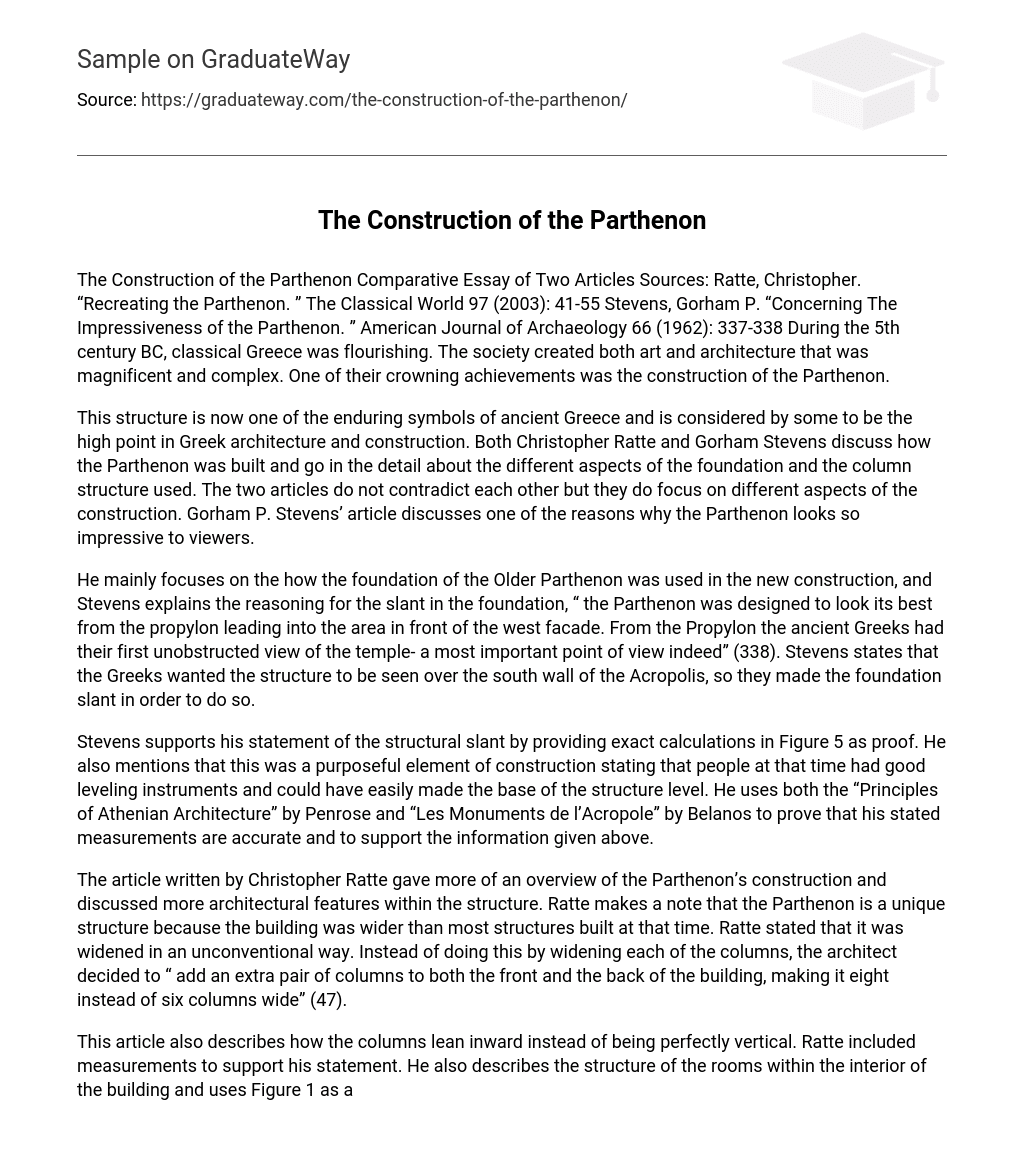Classical Greece thrived during the 5th century BC and boasted a flourishing society that produced magnificent and intricate art and architecture. One of their remarkable accomplishments was the construction of the Parthenon.
The Parthenon is considered a lasting symbol of ancient Greece and a pinnacle of Greek architecture and construction. Christopher Ratte and Gorham Stevens both delve into the Parthenon’s construction, examining its foundation and column structure. While their articles do not contradict each other, they do highlight different aspects of the building process. Specifically, Stevens’ article explores the Parthenon’s visual impact on viewers.
Stevens primarily focuses on how the foundation of the Older Parthenon was utilized in the new construction. he explains that the slant in the foundation was intentional, as the Parthenon was meant to be viewed from the propylon leading to the area in front of its west facade. This viewpoint was considered crucial by the ancient Greeks, as it offered the first unobstructed sight of the temple. The Greeks strategically angled the foundation so that the structure could be seen over the south wall of the Acropolis.
Stevens substantiates his claim about the inclination of the structure by presenting precise calculations in Figure 5 as evidence. He further contends that this was a deliberate aspect of its design, as people in that era possessed proficient leveling instruments and could have effortlessly ensured a level base for the structure. To corroborate his stated measurements and reinforce the aforementioned details, he cites both Penrose’s “Principles of Athenian Architecture” and Belanos’ “Les Monuments de l’Acropole.”
Christopher Ratte’s article provided a broader examination of the construction of the Parthenon, emphasizing its architectural aspects. Ratte highlights the distinctive nature of the Parthenon, noting its exceptional width compared to other contemporary structures. Rather than widening each column individually, the architect opted for an unconventional approach by adding an additional pair of columns both in the front and rear, resulting in a total of eight columns instead of six (Ratte, 47).
This article discusses the Parthenon’s construction in terms of the columns leaning inward instead of being perfectly vertical. Ratte provides measurements to support this observation. He also describes the layout of the rooms inside the building and references Figure 1 as a source for the temple’s design plan. While Ratte does not cite specific information within the article, he does include a selected bibliography at the end to acknowledge his sources. Overall, both articles share similarities and agree on certain aspects of the Parthenon’s construction.
Both authors agree on the significant role of Pericles in the construction of the Parthenon. Stevens refers to it as “the Parthenon of Pericles” (337), while Ratte highlights that it was completed during Pericles’ lifetime. Another shared point is that the temple was a recreation of an original that had been destroyed by the Persians. Additionally, both authors emphasize that the new structure utilized the foundation of the Old Parthenon, indicating that the same site was used for construction.
The only discrepancy found relates to the foundation of the Old Parthenon being used in the new construction, as mentioned by Stevens, while Ratte states that the new temple was partially completed using salvaged materials including column drums (46). It is possible that Stevens supports this statement but chose not to mention it in his article. Additionally, Ratte’s document provides a very brief reference for this phrase, lacking proper documentation.
“Recreating the Parthenon” by Christopher Ratte and “Concerning the Impressiveness of the Parthenon” by Gorham P. Stevens are popular articles that delve into distinct aspects of the Parthenon’s construction. While they do have a slight discrepancy and only a few commonalities, these articles would be ideal resources for an essay on the Parthenon, thanks to their distinctive content. Both articles provide thorough references and explore essential factors involved in designing and building this remarkable temple.





